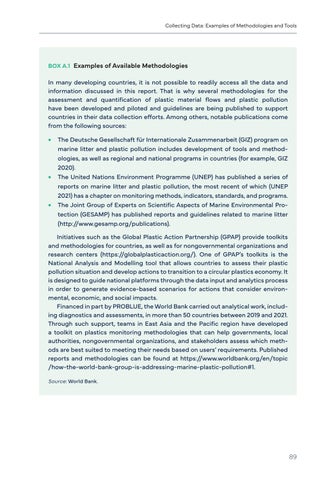Collecting Data: Examples of Methodologies and Tools
BOX A.1 Examples of Available Methodologies
In many developing countries, it is not possible to readily access all the data and information discussed in this report. That is why several methodologies for the assessment and quantification of plastic material flows and plastic pollution have been developed and piloted and guidelines are being published to support countries in their data collection efforts. Among others, notable publications come from the following sources: ••The Deutsche Gesellschaft für Internationale Zusammenarbeit (GIZ) program on marine litter and plastic pollution includes development of tools and methodologies, as well as regional and national programs in countries (for example, GIZ 2020). ••The United Nations Environment Programme (UNEP) has published a series of reports on marine litter and plastic pollution, the most recent of which (UNEP 2021) has a chapter on monitoring methods, indicators, standards, and programs. ••The Joint Group of Experts on Scientific Aspects of Marine Environmental Protection (GESAMP) has published reports and guidelines related to marine litter (http://www.gesamp.org/publications). Initiatives such as the Global Plastic Action Partnership (GPAP) provide toolkits and methodologies for countries, as well as for nongovernmental organizations and research centers (https://globalplasticaction.org/). One of GPAP’s toolkits is the National Analysis and Modelling tool that allows countries to assess their plastic pollution situation and develop actions to transition to a circular plastics economy. It is designed to guide national platforms through the data input and analytics process in order to generate evidence-based scenarios for actions that consider environmental, economic, and social impacts. Financed in part by PROBLUE, the World Bank carried out analytical work, including diagnostics and assessments, in more than 50 countries between 2019 and 2021. Through such support, teams in East Asia and the Pacific region have developed a toolkit on plastics monitoring methodologies that can help governments, local authorities, nongovernmental organizations, and stakeholders assess which methods are best suited to meeting their needs based on users’ requirements. Published reports and methodologies can be found at https://www.worldbank.org/en/topic /how-the-world-bank-group-is-addressing-marine-plastic-pollution#1. Source: World Bank.
89





